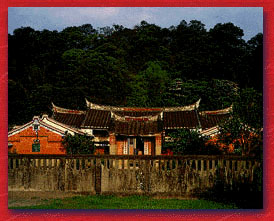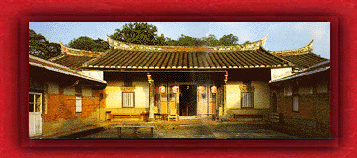CHIN KUANG FU HOUSE
Address/6 Chung-cheng Road, Pei-pu Village, Pei-pu hsiang, Hsinchu County
Construction Date/1834
In 1826 the magistrate of Tamsuim Li Shen-yi, built a 'strategic pass'-defense station- at Shih-sui Lun to guard settlers in the area from raids by local aborigines. Later on, another magistrate, Li Ssu-yeh, planned to extend and enlarge the area of farmland for Chinese cultivation. He ordered two important gentry of the area- Chiang Hsiu-luan from Kwangtung and Chou Pang-cheng of southern Fukien- to organize a committee to oversee further defense operations and extend development of the land.
He also gave them responsibility for the upkeep of Shih-sui Lun and similar installations. Using their influence in the community, Chiang and Chou were able to collect twelve thousand six hundred taels each from Kwangtung and Fukien settlers.
The money was placed in a fund given the name Chin-kuang-fu signifying, 'the everlasting wealth of Kwangtung and Fukien. The fund became operative in 1831.
Money from it was used to build several new strategic passes in 1833, and in 1834 cultivation was extended to the new village of Pei-pu (location of the present site), which was made a base for future development.
By the 1860's the expansion of cultivation had grown considerably, and there was a complete reorganization of the strategic pass network.
This house was the office in charge of adminstering the 'Chin-kung-fu' fund.
A tablet inscribed with the name Chin-kuang-fu still remains above the door of the main hall. Behind the office structure are the buildings of the Chiang residence, a large house in fine traditional style, as well as other structures of historical value.

Above the gate to the second hall by the courtyard hangs this wooden tablet inscribed with the words 'Chin Kuang Fu'
View of the T'ien-shui t'ang, another structure that stands on this site, notable for the strength and beauty with which its architectural forms have been assembled against the natural setting.
View of the central hall, which serves as a shrine for the cult of the lineage ancestors; thr roof design is known as 'moderate swallowtail' ridge. Flanking the ancestral hall are rooms for residential use.




